 By Pepper Parr
By Pepper Parr
April 22nd, 2020
BURLINGTON, ON
In a Statement published in the Mayor’s Newsletter – A Better Burlington – Mayor Meed Ward wrote:
City Council, at a Closed session accepted a proposed revised plan for a townhouse and semi-detached development at 2100 Brant Street. The proposal will be decided by the Local Planning Appeal Tribunal (LPAT) at a hearing scheduled in July.
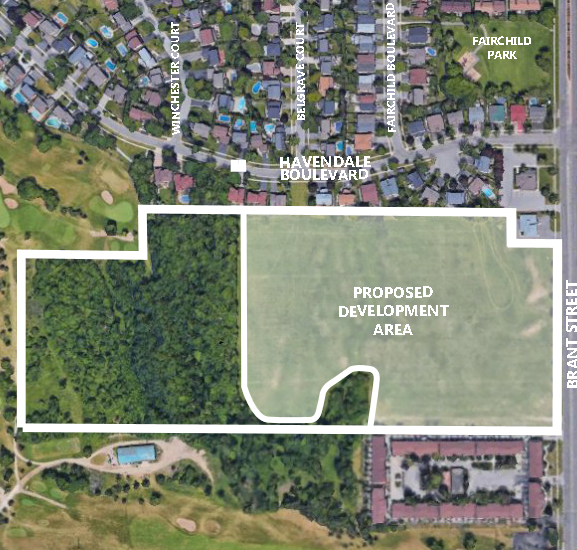
It is a piece of land that was farmed for centuries. It was pristine – and good have been a model community. The plans do not include anything near the traditional back yard.
The original proposal was for 12 townhouse blocks with a total of 83 units and three condominium townhouse blocks with 150 units, for a total development of 233 units. There was no parkland. Also included in the applications are a woodlot block as well as a natural heritage system block. The proposed development site has a total area of 11.1 hectares (27.2 acres). The developable area is 5.04 hectares.
The land is currently vacant and has been historically used for agricultural purposes.
The former City Council had approved a revised proposal in November 2018, before the new council was sworn in but after the election when 5 of 7 members of the previous council were not returning due to defeat or retirement.
Current City Council rescinded that plan in December 2018 in an effort to give residents, staff and the applicant additional time to improve the plan and come to a consensus on a revised development.
A group of citizens, primarily representing residents in the neighbourhood north of the development, formed Vision 2100 Brant Neighbours Association, an incorporated group that received Party status at the LPAT hearing to present evidence on behalf of residents.
Representatives of the townhouse condominium board immediately to the south of the project had earlier issued a letter of support for the November revised proposal, considering their issues (primarily around setbacks and drainage) to be settled.
City Council and Vision 2100 received a revised proposal in March 2020. This proposal was provided directly to the Vision 2100 citizen’s group at a meeting March 10 with the applicant and Ward Councillor. The proposal was further discussed April 2 via teleconference with Vision 2100 representatives and the Ward Councillor and Mayor, to seek citizen input on the proposal.
To date, Vision 2100 has not provided any suggested changes or feedback on the proposal, but did raise additional questions around parking, snow storage, traffic, and storm water management. These were answered by the applicant by email to the residents (see background below), and addressed in the revised proposal to the city’s satisfaction.
The new proposal improves on the original application as well as the November 2018 proposal with the following changes:
Reducing the unit count from 212 to 210 (down from 233 in the original proposal)
In the Northwest area of the development on both sides of the Almonte Drive extension, replacing six 2-storey townhouse units with 4 semi-detached 1.5 storey bungalofts
Increasing setbacks from the homes to the north, from 9 metres to 10 metres; in some areas the setback is 11 metres
Increasing the senior-friendly units with ground floor bedrooms to aid accessibility, from 7 to 16 units
Provision of a 0.3 hectare (0.76 acre) centrally located Public Park.
City council voted to accept the revised proposal at the council meeting of April 20, 2020.
The details of that March plan, and the planning justification for supporting it provided by city staff, are included in the planning staff analysis here: 2100 Brant Planning Analysis
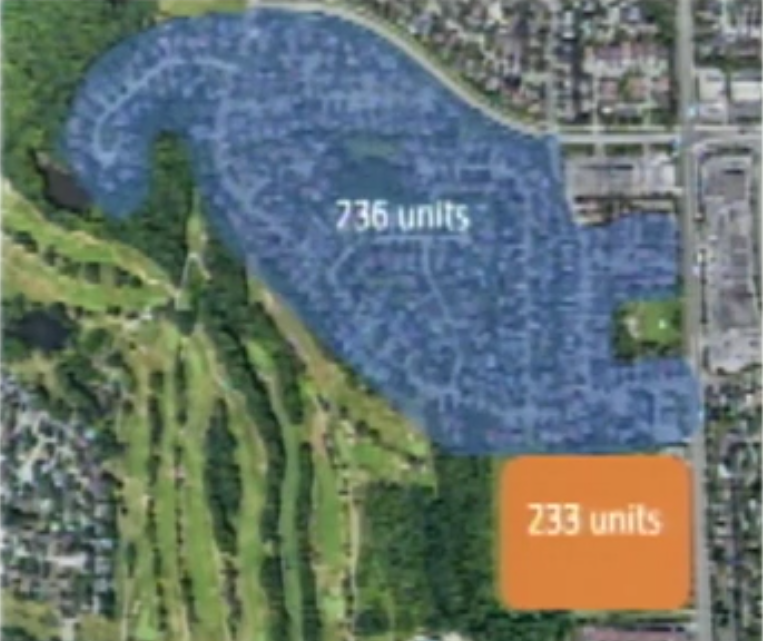
The orange is where the proposed 233 units were to go – that has been reduced to 210
Unlike the vast majority of municipalities, Burlington releases the planning analysis for matters which the municipality is supporting approval of by the LPAT, in advance of the hearing. This policy change was implemented by the new City Council to ensure maximum transparency with residents about the basis of our decision-making.
The final decision on the revised proposal will be made by the LPAT. The city and applicant will appear in support of the proposal.
Vision 2100 is a registered Party to the hearing which gives them the right at the hearing to call evidence (witnesses, studies or both) to refute or support the proposal, cross examine city or applicant witnesses, or suggest further modifications to the proposal. The City of Burlington, the applicant (National Homes) and the Region of Halton are the other registered Parties to the hearing. There are two registered Participants to the hearing who can provide feedback at the hearing as well.
Details on the original application submitted in 2017, revisions to the proposal, and details of the LPAT hearing are available on the project page for the development here created when the application was received: Current Development Applications, Ward 1, 2100 Brant St
Below is additional background, answers to some questions and a statement from the Mayor and Ward councillor.
Statement from Mayor Marianne Meed Ward and Ward 1 Councillor Kelvin Galbraith on 2100 Brant:
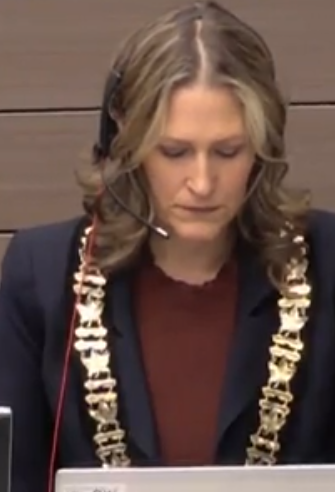
Mayor Marianne Meed Ward
Resident input over several years, including the work of Vision 2100, has improved this application for the better, and we thank them for that.
Though the most recent proposal may not be exactly what residents or Councillors were hoping for, it does include more green space than the original proposal, including a new park, fewer units, less height and density, more variety and senior-friendly options, increased setbacks and better transition to the neighbourhoods to the north and south. The recent questions raised by residents around parking, traffic, snow storage and storm water management have been addressed.
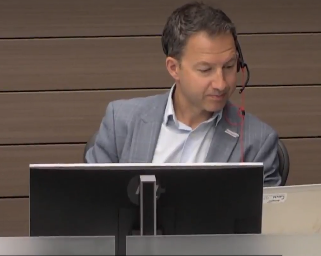
Ward 1 Councillor Kelvin Galbraith – working part time as a DJ?
In accepting the revised proposal, council considered a number of factors, including public input, the improvements made that addressed some of the concerns raised, the planning justification provided by staff, and advice from legal counsel.
Our decision also factored in some practical realities, including the inability to secure a planning witness that was of the opinion that the November 2018 proposal did not overall represent good planning, the likelihood that a hearing would not produce a different result, and the possibility that city taxpayers could be required to pay the entire costs of the applicant at a lengthy hearing. In addition, city staff who supported the November proposal would likely have been required to testify on behalf of the applicant, at city taxpayers expense.
We also considered that notwithstanding council accepting a revised proposal, there remain options for continued public input, especially for Vision 2100, which can provide feedback or modifications on the revised proposal, and/or proceed as a party to the hearing and call evidence and witnesses.
We believe we achieved the best outcome possible for residents in this case, and your input directly made that happen.
Background and Answers to Questions:
How has public input been gathered on this application?
This application has been under review since 2017, with multiple points of public input along the way. A citizen’s group, Vision 2100, was formed to represent the concerns of residents primarily north of the development site. A citizen’s group was formed to the south to represent the interests of the townhouse development to the south. They submitted a letter of support for the November 2018 revised proposal.
The applicant met with the public over 12 times in that period, in either organized public meetings or smaller resident meetings.
There was a neighbourhood meeting Oct. 12, 2017, a statutory public meeting April 3, 2018 where residents presented detailed feedback and suggested modifications to council. Some council members at the time remarked that they were the best and most comprehensive presentations they had heard. There was a further open house to discuss revised plans July 17, 2018.
Throughout 2019 there have been numerous additional consultations with the applicant, city staff and Vision 2100, individually or as a group, to address the remaining concerns of the community. They included general over development of the site with related issues, and the interface of the development to the single family neighbourhood to the north, at Almonte Drive/Belgrave Court/Havendale Blvd.
In February 2020 the applicant advised it was prepared to make changes to the plan to address the resident concerns. In March they submitted a revised proposal to Vision 2100, and city staff. City Council received the proposal in early April.
How is public input reflected in the final proposal?
Since the original application, there have been at least 11 major revisions as a result of public, staff and council input, including a reduction in units, increased parkland, increased setbacks from the neighbourhoods to the north and south, reduced height of some units and conversion from townhouses to semi-detached, and provision of accessible, senior friendly semi-detached bungalofts. There have been three different proposals including the most recent one.
The proposal was provided directly to the Vision 2100 citizen’s group at a meeting March 10 with the applicant and Ward Councillor. The proposal was further discussed April 2 via teleconference with Vision 2100 representatives and the Ward Councillor and Mayor, to seek citizen input on the proposal.
To date, they have not provided feedback on the most recent proposal, but they did raise several outstanding questions via email related to traffic, parking, snow storage and storm water management. These questions were raised with the applicant by the Mayor and Ward Councillor on residents behalf, with the response as follows:
Traffic on Havendale, Fairchild and Brant St. Was a traffic study produced and taken into account? ANSWER: A traffic study was provided to Vision 2100 previously with the analysis describing the difference of a single family development and a townhouse development completed by a professional traffic engineer, outlining that a single family home development would generate more traffic. City staff reviewed and supported the findings of the study.
Parking, no street parking on private roads and limited visitors parking. Where do visitors park? ANSWER: Visitor parking is provided in the development on both public roads interior to the site and private roads as detailed in the attached site plan (also provided to Vision 2100).
The Zoning By-law requires 54 visitor parking spaces, whereas 59 are proposed. In addition 25 on-street parking spaces could be accommodated along the Almonte Drive extension.
Snow removal. There is no room to pile snow. Does the City have a plan to resolve that problem? ANSWER: The site plan attached to the revised proposal identifies areas where snow storage will be designated, in the bottom left and top right areas of the development.
Storm Water management. This has been a serious issue for the residents, based on actual flooding experiences where the empty lot at 2100 Brant served as a sink which helped to mitigate the flooding. Now there will be no sink because the area will be developed. The proposal is for an underground collection system with tanks which can be drained into the existing stormwater sewer at Brant Street. The question is, will there be enough capacity to accommodate two major rain storms in a row and will the system work properly? ANSWER: The design was prepared by a professional engineer based on their experience and history of developing many projects within the GTA with a similar design. Burlington City engineering staff had their professional engineers along with the Region of Halton’s professional engineers review the design of the system and both have been satisfied.
Why was this appealed to the Local Planning Appeal Tribunal?
Developers and residents have equal legal right in Ontario to appeal any decision of city council on a development matter to the LPAT, to seek a different decision.
Further, an applicant can appeal to the LPAT if the municipality exceeds the provincially mandated timelines to make a decision, which at the time of this application were 180 days.
The applicant, residents and staff agreed to continue to work together on the project beyond the 180 day time frame to try to come to a better outcome, thus setting aside the deadline. This application is now in its third year of review.
However, this changed when the previous provincial government announced it was making changes to the LPAT (then called the Ontario Municipal Board) to restrict what could be appealed and giving more priority to local council decisions. The current provincial government rolled back those changes so the LPAT functions essentially the same as the OMB did.
However in that transition period thousands of applications across the province, were preemptively made to preserve rights to a hearing under the old OMB rules, including this one which appealed using the tool of “non decision” within the deadline, because council had not made a decision within the 180 day time frame.
What happens now?
This application and the proposed revised plan will be heard by the Local Planning Appeal Tribunal (LPAT) at a 12-day hearing scheduled to begin July 27. At that hearing, the applicant and city staff, based on City Council’s instructions, will jointly be requesting that the LPAT approve the revised application.
Due to COVID19, the province has cancelled all hearings till the end of June, but that does not apply to 2100 Brant Street as it is beyond that window of time. As such, all parties to the hearing, including Vision 2100, are required to produce evidence and experts to refute the application and revised proposal if they wish to challenge it.
To date, neither the city, nor Vision 2100, were able to find a planner to refute the proposal. This would leave the city without a witness at the hearing, compromising any ability to reach a different outcome at a hearing than the proposed application. In addition, city staff would most likely be called by the applicant to support the proposal, as they initially recommended approval of the November 2018 proposal. This factored into council’s decision to accept the third revised proposal as the best outcome possible, and an improvement on both the original and November proposals.
Entering a hearing without a witness could have also led to an award of costs against the city for the applicant’s expenses of the entire 12-day hearing, saddling taxpayers with a significant bill with no improvement in the outcome of the development. This also factored into council’s decision.
What are the opportunities for further public input on this application?
The next steps and opportunities for further public input at the hearing are detailed below, and were outlined via email to Vision 2100 from the Mayor and Ward Councillor April 10.
Vision 2100 has party status at the hearing. They can present evidence at the hearing regardless of whether any other party enters into a settlement. As such, they retain the opportunity (and obligation as a party) to call evidence against the revised proposal if they are opposed.
An issues list identified for the hearing outlines the issues raised by the various parties. The list is available on the project page on the city’s website. Issues list, attachment 3
There are four parties to the hearing: National Homes, City of Burlington, Vision 2100 and Region of Halton. On the issues list there are 16 issues cited by the city and Vision 2100 (Items 1-12, 14-17); 4 issues cited solely by Region of Halton (Items 13, 18, 19, 21), one issue cited by Region of Halton and Vision 2100 (Item 20), and 2 issues cited only by Vision 2100 (Items 22, 23).
We understand that Vision 2100 has wanted to see the city’s response to various issues and concerns to use in their own efforts at a hearing. Given that city staff previously approved the initial, and the modified (Nov 2018) application, and recommended approval of the March 2020 proposal, any concerns can assume to have been resolved to the city’s satisfaction.
The bulk of the issues raised by the city relate to planning justification matters. These were resolved to the city’s satisfaction, as outlined in the planning justification analysis
Any party can withdraw its issues or settle. Where issues are jointly raised, if one party withdraws from an issue, the remaining party to that issue can still raise it as an issue at a hearing.
Thus, regardless of the actions of the other parties, Vision 2100 retains the option in a hearing to call its own evidence on any of the issues they are listed under, as noted above.
According to the LPAT procedural order, where there are multiple parties listed beside a single issue, those parties have the option to call one single witness together to deal with that issue. This has led to some confusion that the city would call evidence and pay for it on behalf of Vision 2100. That is not the case, as each party remains separate. The City has been clear with Vision 2100 throughout the appeal process that each party, although having the same issues, was separate and should prepare to call its case separately in the event that one of the parties reached a settlement of the appeal.
If the city chose to call evidence on a particular issue, Vision 2100 could rely on that evidence themselves, rather than hire a second individual. If the city did not choose to call evidence, Vision 2100 would then be required to do so themselves. Each party retains independence, with the option to collaborate.
If one of the parties withdraws an item as an issue, or deems it settled and taken care of, the responsibility would be with the remaining party to call its own witness at the hearing, if that party believed that issue has not been resolved, based on their own expert review.
The format of the hearing is that each party must call its own witnesses to support their position of whether or not the application as presented should be approved; each party has the ability to cross-examine the witnesses provided by any other party. The documents in support of the application have been publicly available online since 2017, and residents can review this in advance of a hearing to plan their response. The planning analysis from the city is now also available to residents to plan their response.
A party to the hearing can produce their own evidence to refute the application, and would have opportunity at a hearing to ask questions of others. Regardless of whether there is a settlement, Vision 2100 has this opportunity to ask questions at a hearing, but also an obligation to produce its own evidence for any issues that Vision 2100 has identified on the Issues List.
Summary of options for continued public input:
1. Vision 2100 can undertake to hire their own experts to respond to the material that has been provided by the applicant and is publicly available online. This review may satisfy the concerns raised, or lead to suggested modifications which could in turn be requested of the applicant. Understandably, this is a significant financial undertaking, and may not be feasible.
2. As a resident’s group and as a party to the hearing, Vision 2100 has a unique opportunity to provide a direct public voice on the revised proposal, which they have not done yet. Vision 2100 has an opportunity to review the revised proposal, determine if it satisfies the concerns raised and if not suggest modifications.
3. If the proposed modifications are not accepted, Vision 2100 also has the option to proceed to a hearing, with the obligation to hire experts to refute the applicant’s material (which is publicly available online) and present new evidence in support of any additional proposed changes.
Did the city follow proper planning process on this application?
In dealing with this application, the city has followed the provincial planning process, which is not unique to Burlington but is required across Ontario. The process allows any party independently to determine whether or not its issues have been resolved.
The process allows any party to determine that its issues have not been resolved and proceed to a hearing, but in that case would need to present its own evidence to refute the application.
What is City Council’s role?
City council has an obligation to review and consider any revised proposal. In reviewing the proposal, we consider input from our planning and legal team, the applicant, as well as resident’s groups or individuals. The public is represented in this process in a variety of ways, including through your elected representatives and our voices carrying your input/questions forward, as well as any direct input you have provided to the city, applicant and elected representatives.
Your elected representatives also undertake to ensure that outstanding questions/issues have been addressed in making any decisions.
All means of public input described above have occurred throughout the processing of this application.
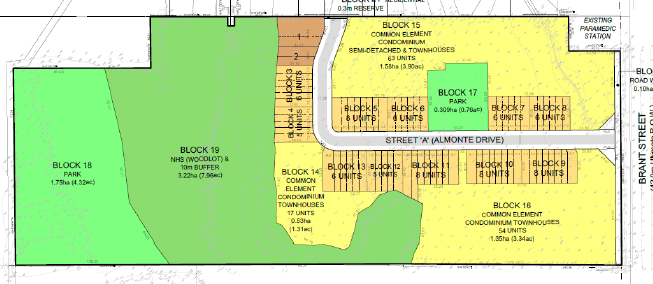
Think traffic flow onto Brant – and pity those that want to make a left hand turn on Brant in the morning rush hour.


















Hi Tom.
Sorry for the confusion. your 1st. sentence. “You know very well that decisions about the rules of development are all a matter of interpretation” Is the only sentence that I would perhaps like to add to. The story of the 5 planners was my rant. The fact that some Provincial Guidelines are fixed and to be obeyed by both sides and not subject to interpretation. An example of this would be time guidelines for applications to be reviewed. Policies about what a City should do in terms of creating by-laws and how long they have after an Official Plan is approved. 3 years I believe. These would be more procedural issues. Sorry about the confusion. If you agree. Then by George! We agree on everything. Good night.
Tom.
I agree with every word you said exept the 1st sentence Development should not be this difficult to understand and be so ambiguous that 5 different planners could come up with 5 different scenarios. The laws of development should be crystal clear. I have always said the Provincial Government should provide direction that cannot be interpreted different ways. Example of this would be highrise buildings. Cities would be classified as A<B<C or D Toronto could be classified as an A City with max. height 40 stories. Hamilton that is smaller a B City would have a height ceiling of 30 stories. Burlington C would have a max height of 15 or 20 stories and so on. Where these shall be allowed shall be determined by the Province working with the Cities. Once these designations are put in place. For low, medium and high density they remain fixed unless changed at a later time by Provincial Governments working with the Cities. Each property in Burlington would have an easy to read and understand designation with permitted uses that cannot be changed. Subject to ultimate uses such as 2 properties side by side where the highest and best use for planning would be to create 1 larger property. This way every man women and child could input an address of a property and know exactly what will be allowed to be built on that property if anything. All this nonsense would be gone. Would the people of Burlington have a say? Yes in the Provincial elections.
Alfred,
We really agree on every word from what you say here.
I didn’t say that “Development should this difficult to understand and so ambiguous that 5 different planners could come up with 5 different scenarios.”
What I said and meant was that, in fact, it really is this way, not that it should be.
I agree that it should not.
In the Mayor’s statement she has identified the Issues list which is a document that list common items for both the City and Vision 2100 Brant.
The big issues are major revisions to the Official Plan and zoning bylaws and the resulting Over development with all its consequences. The only change from the settlement agreement approved by previous Council in November 2018 has been the deletion of two townhouses and the conversion of 8 townhouses to bungalofts.
Is that enough to mitigate the issues on 26 variances to the Official Plan and Over development?
What happened to the slogan “Stand by your Plan”
Alfred,
You know very well that decisions about the rules of development are all a matter of interpretation. Your personal story for another time.
What is allowed to pass for these interpretations are the “opinions” of proponent paid professional mercenaries, who are self appointed so-called “expert witnesses” and are the only ones allowed to make opinion evidence and testimony saying what these interpretations are, and have them recognized at LPAT.
Even a planning experienced citizen, using the same logic and planning OP and ZBL rules, that they interpret to say that some amendment(s) that are lesser than asked for still conform to the PPS, and comparatively, the proponent “expert” says it is not enough, and so does not conform to the PPS, the “expert” opinion interpretation will be recognized as uncontroverted by the citizen and accepted as fact at LPAT.
These “expert” opinions are usually the only ones accepted by the OMB/LPAT Chairs as adjudicators. This exclusive domain given to professionals paid to represent developers illustrates the underlying conflict of interest in using “experts” hired by developers lawyers.
This planning practice marginalizes citizens and debases and ignores the value of their expertise.This perpetuates the offensive lie that citizens have any real say in planning and more so at LPAT.
So in fact in this case, and all the others like it, we have the City lawyers and planners appearing to be working with developer lawyers and planners as a “team” in agreeing to settlements in secret, raising questions about whether they represent the residents of the city.
At the actual Hearing for 2100 Brant, since the City legals failed to deliver on a promise of an independent “expert” planner to keep the process honest, citizens not so represented will be up against this developer and city legal team stacked house.
We won’t hear a word from city planners defending their evidence and subjecting themselves to the citizen Party of Vision 2100 cross examination of this evidence in support of the proposed settlement.
This is standard operating practice. It’s a rigged and subverted system, it stinks to high heaven, and it’s getting worse.
Congratulations to the Mayor and councilor Galbraith and the rest of council. For explaining the rules of Development in Ontario. Clearly you can’t just say no to everything. I really like the idea of senior friendly semi-detached homes. They are permitted according to the Official Plan in the low density areas as well.. Another story for another time..